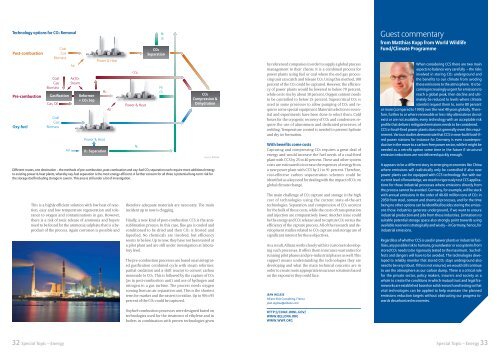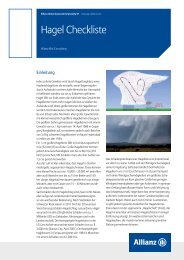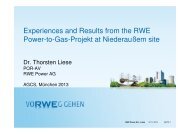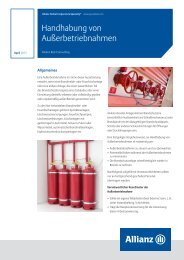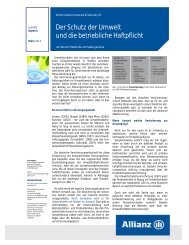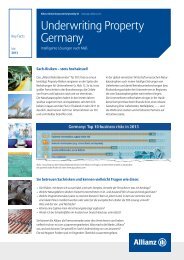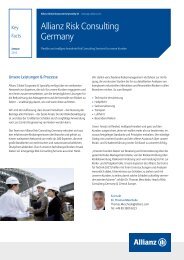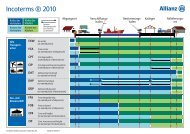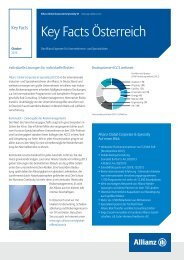Energy - Allianz Global Corporate & Specialty
Energy - Allianz Global Corporate & Specialty
Energy - Allianz Global Corporate & Specialty
Create successful ePaper yourself
Turn your PDF publications into a flip-book with our unique Google optimized e-Paper software.
Technology options for CO2 Removal<br />
Post-combustion<br />
Pre-combustion<br />
Oxy-fuel<br />
Coal<br />
Gas<br />
Biomass<br />
Gasification<br />
Gas, Oil<br />
Coal<br />
Gas<br />
Biomass<br />
Coal<br />
Gas<br />
Biomass<br />
32 Special Topic – <strong>Energy</strong><br />
Air<br />
Air<br />
Air/O2<br />
Steam<br />
Reformer<br />
+ CO2 Sep<br />
Power & Heat<br />
O2 Separation<br />
Power & Heat<br />
This is a highly efficient solution with low heat of reaction,<br />
easy and low temperature regeneration and tolerance<br />
to oxygen and contaminations in gas. However,<br />
there is a risk of toxic release of ammonia and buyers<br />
need to be found for the ammonia sulphate that is a byproduct<br />
of the process. Again corrosion is possible and<br />
H2<br />
Air<br />
CO2<br />
Power & Heat<br />
N2<br />
N2<br />
O2<br />
CO2<br />
Separation<br />
N2<br />
O2<br />
CO2<br />
Compression &<br />
Dehydration<br />
Source: Bellona<br />
Different routes, one destination – the methods of pre-combustion, post-combustion and oxy-fuel CO ² separation each require more additional energy<br />
to existing power & heat plants, whereby oxy-fuel separation is the most energy-efficient. A further concern for all three is potential long-term risk for<br />
the storage itself including storage in cavern. This area is still under a lot of investigation.<br />
therefore adequate materials are necessary. The main<br />
incident up to now is clogging.<br />
Finally, a new kind of post-combustion CCS is the antisublimation<br />
process. In this case, flue gas is cooled and<br />
conditioned to be dried and then CO2 is frosted and<br />
liquefied. No chemicals are involved, but efficiency<br />
seems to be low. Up to now, they have not been tested at<br />
a pilot plant and are still under investigation at laboratory<br />
level.<br />
The pre-combustion processes are based on an integrated<br />
gasification combined cycle with steam reformer,<br />
partial oxidation and a shift reactor to convert carbon<br />
monoxide to CO2. This is followed by the capture of CO2<br />
(as in post-combustion unit) and use of hydrogen and<br />
nitrogen in a gas turbine. The process needs oxygen<br />
coming from an air separation unit. This is the shortest<br />
term for market and the easiest to realize. Up to 90 to 95<br />
percent of the CO2 could be captured.<br />
Oxyfuel-combustion processes were designed based on<br />
technologies used for the treatment of ethylene and in<br />
boilers in combination with proven technologies given<br />
by referenced companies in order to supply a global process<br />
management to their clients. It is a combined process for<br />
power plants using fuel or coal where the end gas processing<br />
unit can catch and release CO2. Using this method, 100<br />
percent of the CO2 could be captured. However, the efficiency<br />
of power plants would be lowered to below 70 percent,<br />
while costs rise by about 30 percent. Oxygen content needs<br />
to be controlled to below 25 percent. Supercritical CO2 is<br />
used in some processes to allow pumping of CO2 and requires<br />
some special equipment. Material selection is essential<br />
and experiments have been done to select them. Cold<br />
boxes for the cryogenic recovery of CO2 and condensers require<br />
the use of aluminium and dedicated processes of<br />
welding. Temperature control is needed to prevent hydrate<br />
and dry ice formation.<br />
With benefits come costs<br />
Capturing and compressing CO2 requires a great deal of<br />
energy and would increase the fuel needs of a coal-fired<br />
plant with CCS by 25 to 40 percent. These and other system<br />
costs are estimated to increase the expenses of energy from<br />
a new power plant with CCS by 21 to 91 percent. Therefore,<br />
cost-effective carbon sequestration schemes could be<br />
identified as a key need for dealing with the impact of CO2 on<br />
global climate change.<br />
The main challenge of CO2 capture and storage is the high<br />
cost of technologies using the current state-of-the-art<br />
technologies. Separation and compression of CO2 account<br />
for the bulk of these costs, while the costs of transportation<br />
and injection are comparatively lower. Another issue could<br />
be the energy and CO2 release used to capture CO2 versus the<br />
efficiency of the capture process. All of the research and development<br />
studies related to CO2 capture and storage are of<br />
significant interest for these objectives.<br />
As a result, <strong>Allianz</strong> works closely with its customers develop -<br />
ing such processes. It offers them insurance warranties for<br />
running pilot phases and pre-industrial phases as well. This<br />
support means understanding the technologies they are<br />
developing and what the main technical concerns are in<br />
order to create more appropriate insurance solutions based<br />
on the exposures they could face.<br />
JEAN INGLESE<br />
<strong>Allianz</strong> Risk Consulting, France<br />
jean.inglese@allianz.com<br />
HTTP://CDIAC.ORNL.GOV/<br />
WWW.BELLONA.ORG<br />
WWW.WWF.ORG<br />
Guest commentary<br />
from Matthias Kopp from World Wildlife<br />
Fund/Climate Programme<br />
When considering CCS there are two main<br />
aspects to balance very carefully – the risks<br />
involved in storing CO2 underground and<br />
the benefits to our climate from avoding<br />
these emissions to the atmosphere. It is becoming<br />
increasingly urgent for emissions to<br />
reach a global peak, then decline and ultimately<br />
be reduced to levels where climate<br />
scientist request them to, some 80 percent<br />
or more (compared to 1990) over the next 40 years globally. Therefore,<br />
further to or where renewable or less risky alternatives do not<br />
exist or are not available, every technology with an acceptable risk<br />
profile that delivers mitigated emissions needs to be considered.<br />
CCS in fossil-fired power plants does not generally meet this requirement.<br />
Various studies demonstrate that CCS in new-built fossil-fired<br />
power stations for instance for Germany is even counterproductive<br />
in the move to a carbon-free power sector, while it might be<br />
needed as a retrofit option some time in the future if structural<br />
emission reductions are not delivered quickly enough.<br />
It appears to be a different story in emerging economies like China<br />
where emissions will realistically only be controlled if also new<br />
power plants can be equipped with CCS technology. But with our<br />
current level of knowledge, we need to rigorously test CCS applications<br />
for those industrial processes where emissions directly from<br />
the process cannot be avoided. Germany, for example, will be stuck<br />
with annual emissions in the order of 40-60 million tons of CO2 in<br />
2050 from steel, cement and chemical processes, and for the time<br />
being no other options can be identified besides storing the emissions<br />
those industries generate underground, if we want to ensure<br />
industrial production and jobs from those industries. Limitations to<br />
suitable potential storage space also strongly point towards using<br />
available reservoirs strategically and wisely – in Germany, hence, for<br />
industrial emissions.<br />
Regardless of whether CCS is used in power plants or industrial facilities,<br />
any possible risk to humans, groundwater or ecosystems from<br />
stored CO2 needs to be rigorously tested to the maximum. Such effects<br />
and dangers will have to be avoided. The technologies developed<br />
to reliably monitor that stored CO2 stays underground also<br />
need to be very robust. If this is not ensured, we would still continue<br />
to use the atmosphere as our carbon dump. There is a critical role<br />
for the private sector, policy makers, insurers and society as a<br />
whole to create the conditions in which mutual trust and legal frameworks<br />
are established based on solid research and testing so that<br />
vital technologies can be applied to help maintain the planned<br />
emissions reduction targets without obstructing our progress towards<br />
decarbonized economies.<br />
Special Topic – <strong>Energy</strong> 33


